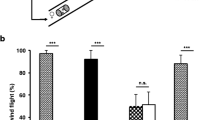Abstract
In addition to 2-methyl-4-heptanone, 6-methyl-5-hepten-2-one, and iridodials, the anal gland exudate of the dolichoderine ant,Tapinoma simrothi, contains 4-heptanone and 4-hydroxy-4-methyl-2-pentanone. The secretion functions as an alarm pheromone.
Similar content being viewed by others
References
Abou-Donia, S.A., Fish, L.J., andPattenden, G. 1971. Iridodial from the odoriferous glands ofStaphylinus olens (Coleoptera: Staphylinidae).Tetrahedron Lett. 1971:4037–4038.
Bedekar, A.N., Dikshit, D.V., Deodhar, K.D., andKulkarni, R.A. 1979. Chemical investigation of indigenous plant resources.J. Ind. Chem. Soc. 56:941.
Bellas, T.E., Brown, W.V., andMoore, B.P. 1974. The alkaloid actinidine and plausible precursors in defensive secretions of rove beetles.J. Insect Physiol. 20:277–280.
Blum, M.S., 1969. Alarm pheromones.Annu. Rev. Entomol 14:57–80.
Blum, M.S., andHermann, H.R., 1978a. Venoms and venom apparatuses of the Formicidae: Dolichoderinae and Aneuretinae, pp. 871–894,in S. Bettini (ed.).Arthropod Venoms. Springer-Verlag, Berlin.
Blum, M.S., andHermann, H.R. 1978b. Venoms and venom apparatuses of the Formicidae: Myrmeciinae, Ponerinae, Dorylinae, Pseudomyrmecinae, Myrmicinae and Formicinae, pp. 801–869,in S. Bettini (ed.).Arthropod Venoms. Springer-Verlag, Berlin.
Blum, M.S., Doolittle, R.E., andBeroza, M. 1971. Alarm pheromones: Utilization in evaluation of olfactory theories.J. Insect. Physiol. 17:2351–2361.
Brown, W.V., andMoore, B.P. 1979. Volatile secretory products of an Australian formicine ant of the genusCalomyrmex (Hymenoptera: Formicidae).Insect Biochem. 9:451–460.
Cavill, G.W.K., Houghton, E., McDonald, F.J., andWilliams, P.J. 1976. Isolation and characterization of dolichodial and related compounds from the Argentine ant,Iridomyrmex humulis.Insect Biochem. 6:483–490.
Emery, C. 1925. Révision des espèces paléarctiques du genreTapinoma.Rev. Suisse Zool. 32:45–64.
Hefetz, A., andLloyd, H.A. 1982. Exocrine glands ofPolyrhachis simplex: Chemistry and function.J. Chem. Ecol. 8:635–639.
Heller, S.R., andMilne, G.W. A. (eds.). 1978. EPA/NIH Mass Spectral Data Base, Vol. 1. U.S. Government Printing Office, Washington, DC, p. 168.
Kallio, H. 1976. Identification of vacuum steam-distilled aroma compounds in the press juice of arctic brambleRubus arcticus L.J. Food Sci. 41:555–562.
McGurk, D.J., Frost, J., Waller, G.R., Eisenbraun, E.J., Vick, K., Drew, W.A., andYoung, J. 1968. Iridodial isomer variation in dolichoderines.J. Insect Physiol. 14:841–845.
Olubajo, O., Duffield, R.M., andWheeler, J.W. 1980. 4-Heptanone in the mandibular gland secretion of the nearctic ant,Zacryptocerus varions (Hymenoptera: Formicidae).Ann. Entomol. Soc. Am. 73:93–94.
Pavan, M., andTrave, R. 1958. Etudes sur les formicidae. IV. Sur le venin du dolichoderideTapinoma nigerrimum.Insect. Soc. 5:299–308.
Stenhagen, E., Abrahamsson, S., andMcLafferty, F.W. (eds.). 1974. Registry of Mass Spectral Data, John Wiley & Sons, New York; (a) Vol. 1, p. 161; (b) Vol. 1, p. 564.
Stumper, R. 1921. Etudes surles fourmis. Recherches critiques sur l'odorat.Bull. Soc. Entomol. Belg. 3: 24–30.
Trave, R., andPavan, M. 1956. Veleni degli insetti. Principi estratti dalla formicaTapinoma nigerrimum Nyl.Chem. Ind. Milano 38:1015–1019.
Tsuneya, T., Ikeda, N., Shiga, M., andIchickawa, N. 1979. GC-MS analysis of gardenia flower volatiles.Seventh Int. Congr. Essent. Oils (Pap.) 1977. 7:454–457.
Vale, G.A. 1980. Field studies of the responses of tsetse flies (Glossinidae) and other Diptera to carbon dioxide, acetone and other chemicals.Bull. Entomol. Res. 70:563–570.
Vidari, G., De Bernardi, M., Pavan, M., andRagozzino, L. 1973. Rose oxide and iridodialfrom Aromia moschata L. (Coleoptera: Cerambycidae).Tetrahedron Lett. 1973:4065–4068.
Wilson, E.O., andPavan, M. 1959. Glandular sources and specificity of some chemical releasers of social behavior in dolichoderine ants.Psyche 66:70–76.
Author information
Authors and Affiliations
Rights and permissions
About this article
Cite this article
Hefetz, A., Lloyd, H.A. Identification of new components from anal glands ofTapinoma simrothi pheonicium. J Chem Ecol 9, 607–613 (1983). https://doi.org/10.1007/BF00990412
Received:
Revised:
Issue Date:
DOI: https://doi.org/10.1007/BF00990412




